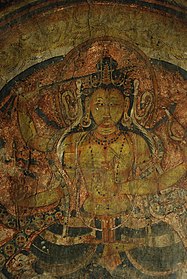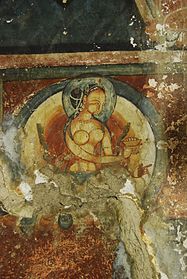Mangyu temple complex
| Mangyu temple complex | |
|---|---|
 Royal drinking scene at the entrance of the monastery at Mangyu, 11th to 13th century CE.[1] | |
| Religion | |
| Affiliation | Tibetan Buddhism |
| Location | |
| Location | Mangyu, Ladakh, India |
| Geographic coordinates | 34°14′0.41″N 77°3′15.07″E / 34.2334472°N 77.0541861°E |
| Architecture | |
| Style | Tibetan Architecture |
The Mangyu temple complex located in the village of Mangyu, Ladakh is one of the earliest in Ladakh, India. Believed to be contemporaneous to the temples at Alchi Monastery and Sumda Chun, the earliest structures are supposed to be dating to the late 12th/early 13th century[2] but as per the oral history and local belief the temples were established by Lotsawa Rinchen Zangpo.[3] Main temple complex comprise two early temples (Sakyamuni and Vairocana temples) situated adjacent to each other and two chapels, one each on either side of the temples, that house large images of two armed and four armed Maitreya.[4] It lies 22 22 kilometres (14 mi) southwest of Alchi Monastery.
The Sakyamuni temple with a beautiful image of Sakyamuni on the North West wall is also known as Chenrezig Lakhang where as Vairocana temple with assemblage of sculptures on NW wall is known as Nangbar Nangzad [5] and the chapels on either side are known as Chamba Lakhang. Another two important structures are early period painted chortens, one of them known as four image Chorten due to the four sculptures inside it. While the early structures are under the administration of Likir Monastery with one resident monk appointed by the monastery carrying out religious activities in the temples, a new temple built slightly above these early structures is under the administration of Matho Monastery.
Unfortunately some of the wall paintings were lost and some were repainted in the past, especially those in the Vairocana temple. But still there are good quality authentic paintings at this site and at present Likir monastery is very keen to conserve them without any repainting/retouching which is commendable.
Access and amenities
[edit]Mangyu village is accessible by motorable roads and is about 70 km from Leh, a journey that will take about 2 hours by cabs. Important monasteries and sites like Basgo, Saspol, Alchi are all in this route with minor deviations. There are bus services from Leh to Mangyu twice a week. Mangyu is at a distance of about 15 km from Alchi monastery.
In 2013 there were three shops in the village with various stationery items that include water, bottled soft drinks, tea, noodles, biscuits etc. There is a good home stay, Mangyu guest house, with three rooms, two with attached toilets.
Conservation
[edit]Architectural conservation of all the temples and chapels and conservation of paintings of Sakyamuni temple were carried out by the Architectural and Material Heritage divisions of the Delhi chapter of Indian National Trust for Art and Cultural Heritage (INTACH). The project carried out in five seasons was funded by Shinnyo-en.[6][7]
-
Manjusri, SW wall, Sakyamuni Temple Mangyu.
-
Female deity - Mangyu, Ladakh.
-
Wall painting, Four Image Chorten, Mangyu
See also
[edit]References
[edit]- ^ Flood, Finbarr Barry (2017). A Turk in the Dukhang? Comparative Perspectives on Elite Dress in Medieval Ladakh and the Caucasus. Austrian Academy of Science Press. p. 244.
- ^ Luczanits, Christian (2004). Buddhist sculpture in clay : early western Himalayan art, late 10th to early 13th centuries. Chicago: Serindia Publ. pp. 167–174. ISBN 9781932476026.
- ^ sTopgays, Sonam. "Monasteries of Ladakh and places of interest". Sonam Adventure Tour & Travel. Retrieved 1 March 2014.
- ^ Van Ham, Peter (2010). Heavenly Himalayas : the murals of Mangyu and other discoveries in Ladakh. Munich: Prestel. ISBN 9783791345437.
- ^ Lee, Eva. "Pristine Mangyu?". Retrieved 1 March 2014.
- ^ "Japanese funding for INTACH". The Hindu. Retrieved 31 December 2013.
- ^ "Statement showing details of funds received & spent by INTACH under FCRA during 2013-14 (upto 18.9.2013)". INTACH. Archived from the original on 27 December 2013. Retrieved 31 December 2013.





